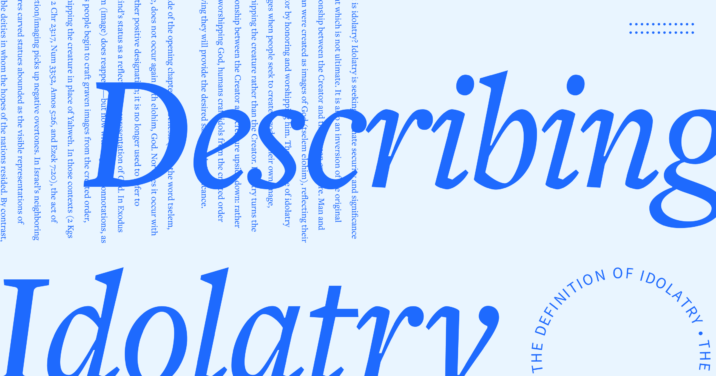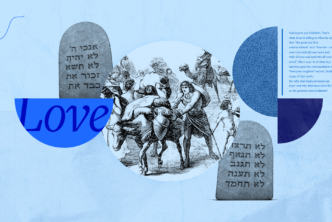What is idolatry?
Idolatry is seeking ultimate security and significance in that which is not ultimate. It is also an inversion of the original relationship between the Creator and the human creature. Man and woman were created as images of God (tselem elohim), reflecting their Creator by honoring and worshipping him. The practice of idolatry emerges when people seek to create a god in their own image, worshipping the creature rather than the Creator. Idolatry turns the relationship between the Creator and creature upside down: rather than worshipping God, humans craft idols from the created order believing they will provide them desired safety and significance.
Images as idols
Outside of the opening chapters of Genesis (1–11), the word tselem, “image,” does not occur again with elohim, “God.” Nor does it occur with any other positive designation; it is no longer used to refer to mankind’s status as a reflection or representation of God. In Exodus, tselem does reappear—but now with negative connotations, as God’s people begin to craft graven images from the created order, worshipping the creature in place of Yahweh. In those contexts (2 Kgs 11:18; 2 Chr 23:17; Num 33:52; Amos 5:26; Ezek 7:20), the act of reflection/imaging picks up negative overtones. In Israel’s neighboring cultures, carved statues abounded as the visible representations of invisible deities in whom the hopes of the nations resided. By contrast, in Israel there were to be no carved images, because God had already made a concrete image both visible and tangible to all who would look: humankind.
Israel’s exodus from Egypt is swiftly followed by their precarious journey into the Sinai wilderness. Israel at this point does not know from where food or water will come, nor how they will navigate the harsh desert. They are met with a surprising series of displays of Yahweh’s faithfulness to them. Geographical guidance is provided by a pillar of fire by night and a moving cloud throughout the day. Water flows from a rock. Bread descends from heaven. Quail rains down mysteriously from the skies. Despite these experiences, Israel refuses to accept that God will continue to provide for them.
The golden calf
The landmark Old Testament text regarding idolatry is Exodus 32, the golden calf incident. This is a paradigm text which echoes across the rest of the Old Testament. At the outset, Israel cannot grasp how God could care for them in the wilderness—most especially without their anointed leader, Moses, who has ascended the mountain into a cloud. In their disbelief, they craft a molten image of a cow, convincing themselves that it will give them food in the desert. (They likely model this cow upon the agrarian idols of Egypt from whence Israel had recently come.) Israel even appears to attribute their deliverance from Egypt to this golden calf they have just fashioned (Exod 32:5)!
From the cloud on top of the Mount, Yahweh tells Moses that the Israelites are “your people whom you brought up out of the land of Egypt” (Exod 32:7). Moses responds by reminding God that they are “your people whom you have brought out of Egypt” (Exod 32:11). The question of “belonging” is the critical question in the narrative, and it continues throughout the remainder of the canon. To whom do the people belong? And to whom do they confess ownership? These are the questions of identity at the heart of the story of idolmaking in Exodus 32. Yahweh’s covenantal ownership of Israel is threatened by the attempt to grant ownership rights to the idols. Their purpose and significance becomes as fragile as the calf that could be made one day and smelted out of existence the next. From this point forward in Israel’s history, acts of rebellion are characterized by appeal to the calf’s attributes—a stiff neck, a hard heart, ears that cannot hear and eyes that cannot see.
Isaiah’s mockery of idolatry
The prophet Isaiah offers the clearest and richest denunciation of idolatry in the period of the monarchy. The second half of Isaiah opens with four spiraling poems, each referencing the confrontation between Yahweh and the gods of the nations. In Isaiah 40, the idolmaker is portrayed as God-like in his creative abilities. But unlike God, the idolmaker grows faint, and his strength diminishes. He becomes hungry and thirsty as all humans do. God not only does not grow weary or faint, but—in that familiar refrain of Isaiah 40:31—“they who wait for the Lord shall renew their strength; they shall mount up with wings like eagles; they shall run and not be weary; they shall walk and not faint.”
At a certain point Isaiah’s argument becomes satirical. The idolmaker cuts down trees to make his idols. He uses some of the wood for cooking, some of it for heating, and the remainder to make his gods—as if the scraps of wood are worthy objects of worship. This satire unveils the irrationality of idolatry. The idolmaker ventures to make his own idol as the means to control his own significance and safety.
Christ the image
In the New Testament Christ, by contrast, is the “exact representation” of God; he is the means by which the invisible God becomes visible (see Heb 1:5 and John 1:18 ). Christ is the perfect image who suffers in our place and for our redemption (Eph 5:25–26). As a consequence, human identity is most clearly seen in Christ—the one in whom, through whom, and for whom humankind was made (1 Cor 8:6; Col 1:16). Surprisingly to anyone who has followed the Old Testament story, God does have a concrete and visible image: Jesus. And though the incarnation may appear to be grounds for accusing Christianity of idolatry, the apostles claim that the visibility of Christ as the image of God (eikon tou theou) is precisely what inverts the corrupted order of idolatry. In Christ, the Creator enters into the creation and thereby recreates the cosmic order after his image.
Paul and the gentile gods
Gentile nations thought of idolatry in positive and beneficial terms. Their idols were physical representations of the gods who were worshipped locally. As the cult of the emperor grew in the first century, there were temples constructed to the pantheon of the Greco-Roman gods—with the emperor now included. These “national” gods and their idols were to be respected and revered across the breadth of the empire. According to the apostle Paul, this was a monumental and terrible theological exchange (Rom 1). The glory of God was being exchanged for images of every sort of creature: men and birds and land animals and even reptiles. This description of the tragic exchange at the center of idolatry is a Pauline way of providing a big picture of human corruption. The apostle echoes the familiar canonical claim that there is no comparison between the Creator and the creature, and yet humans have persuaded themselves that other created things would satisfy their deepest longings.
There are important contrasts throughout Paul’s argument in Romans 1 illuminating the emotional power of idolatry. Hoping to hold down the truth, humans were held down by unrighteousness (1:18). That which can plainly be seen was exchanged for darkness (1:20–21). Though they knew God, they did not know God (1:21). Claiming to be wise, they became fools (1:22). The glory of God was exchanged for but a dim image. The shadow was embraced rather than the reality (1:23). Refusing to honor God, they dishonored themselves (1:24). Truth was exchanged for a lie (1:25). In each of these exchanges there was a turning upside down, an “inside-outing” of the created order.
In 1 Corinthians 10, Paul picks up another familiar line of argument against idolatry as he turned his attention to the Isaiah 44 argument that idols are neither living nor do they represent gods that exist. The non-living idols represent non-existent gods. Paul admonished the Corinthians to flee from idolatry because the gods represented did not actually exist. In this light, they surely could not provide any grounds for hope in the face of adversity. Paul’s response was to treat the idols with the respect they deserved, namely none.
In Acts 17, Paul confronts the common religious idolatry of the Greco-Roman world at Athens, a city filled with idols. Its long and distinguished history had in part been tied to the heritage of temples and statues dedicated to a variety of emperors and gods. There were also several altars to unknown gods to ensure that no gods were omitted from their rightful place within the pantheon of gods represented at Athens.
Paul’s critical argument at Athens hinges powerfully on whether it makes sense to suppose that the Creator of the world can be fashioned out of gold or silver. It was God who created humankind, not the reverse. God is not an image that could be formed from the imagination or creativity of human artists. Paul claims that it would be illogical to suppose that humans could find their safety and significance by creating the god who gives them meaning.
Jesus the image
What most significantly marks out the New Testament as the fulfillment of the Old Testament is the claim that the imago dei attained a unique status in the person of Jesus Christ, not merely as a human but as the perfect image of God. It was not an abstract metaphysical claim, but primarily a confession about Jesus as Lord. The claim that Jesus was the “image of the invisible God” (Col 1:15) was the means to establish that God was renewing/restoring/ redeeming his people into his image. As the image of God, Jesus was “reconciling to himself all things, whether on earth or in heaven, making peace by the blood of his cross” (Col 1:20).
If idolatry is the theological act of honoring the creature as if it were the Creator, Jesus is the one who reverses this “theological move” by re-constituting the imago dei with the full reflection of the divine glory in his own person. Jesus is the true image in contrast to the false idol (cf. 1 Cor 12; 2 Cor 6). The idols represent the attempt to find significance and security by the works of one’s own hands. By contrast Jesus is the one whose significance and security from beginning to end are found not in the labors of his own hands, but in sacrificing his life for others in covenantal obedience to his Father. Though he is equal with God, he does not consider that status as grounds to assert control on his own terms (Phil 2:6–8). Rather, he willingly obeys his Father even at the cost of his own life. He is the inverted idol of God, the one who humbles himself to the point of death on a cross.
Modern idols
One of the great ironies of modern times is the use of idolatry as an argument against Christianity. In the hands of the secular prophets (Ludwig Feuerbach, Frederick Nietzsche, Sigmund Freud, etc.), Christians are those who have created a god in their own image—a god who is simply a projection of their desire for a god-like human, a god who would justify their prejudices. These thinkers argued that the Christian god is a figment of the Christian imagination. In response to these secular prophets: though all humans, including Christians, possess this idolmaking capacity, the truth is that no one would create a God who was utterly sovereign and holy. This is not a god who can be easily manipulated, but was rather the Creator of the universe that held all of humanity’s destiny in his hands.
Idolatry remains a theologically important concept for contemporary Christians. It provides a pungent reminder that we are all prone to find security and significance in places other than the God who created and redeems us. We no longer bring carved statues into worship, but powerful present realities such as money, sex, and power often subvert our deepest longings for God. These idols become illusory attempts to find safety or significance in that which we control. Often our deep anxieties related to job, family, reputation, or retirement are accompanied by attempts to calm those anxieties with idols. It is when we turn good things into God-things by attempting to create safety and significance on our own terms that we enter into the land of idolatry.
We must recognize that the idols of our own making are no match for the one, true, and living God.
Related articles
- Lust, Idolatry & the Power of A Stronger Desire
- Idolatry in the Bible: Animals, Demons, and the Desert
- The Attributes of God: Who God Is & Why It Matters
For further reading
Identity and Idolatry: The Image of God and Its Inversion (New Studies in Biblical Theology, vol. 36 | NSBT)
Regular price: $19.99
Mobile Ed: PD102 Idolatry and the Power of the Cross (2 hour course)
Regular price: $79.99
Counterfeit Gods: The Empty Promises of Money, Sex, and Power, and the Only Hope that Matters
Regular price: $13.99








